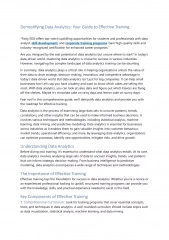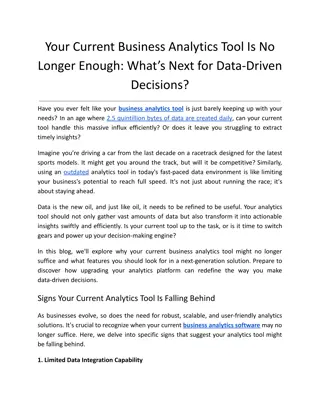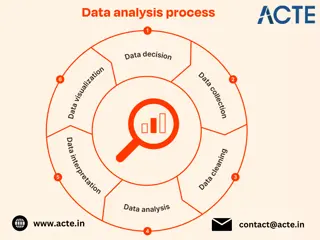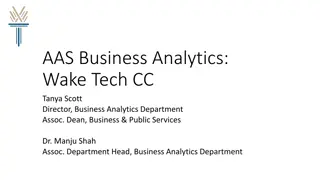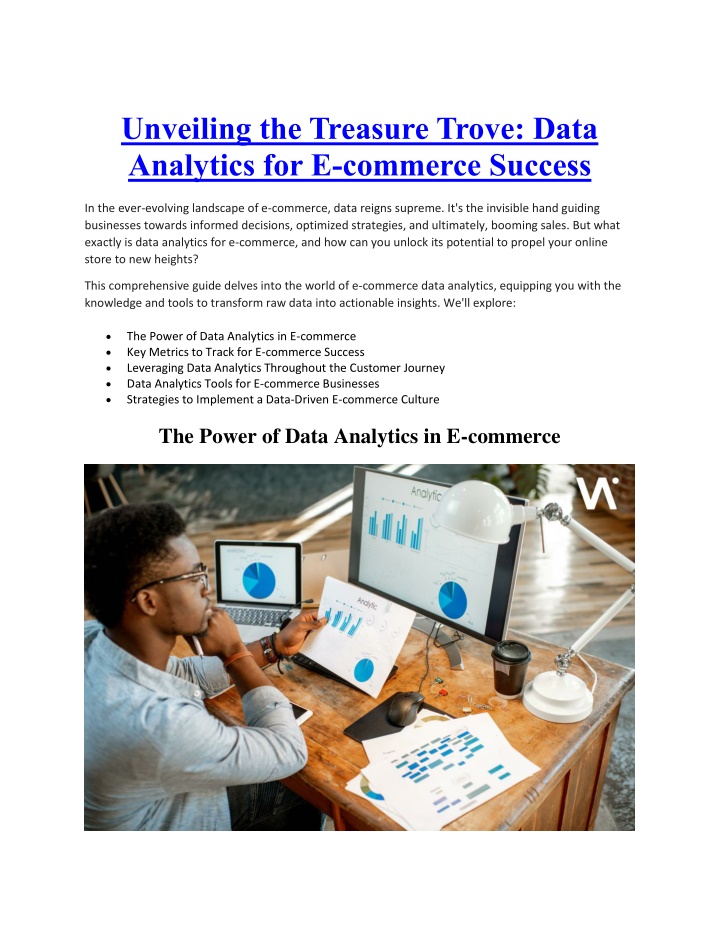
Unveiling the Treasure Trove- Data Analytics for E-commerce Success
In the ever-evolving landscape of e-commerce, data reigns supreme. It's the invisible hand guiding businesses towards informed decisions, optimized strategies, and ultimately, booming sales. But what exactly is data analytics for e-commerce, and how
Download Presentation

Please find below an Image/Link to download the presentation.
The content on the website is provided AS IS for your information and personal use only. It may not be sold, licensed, or shared on other websites without obtaining consent from the author. If you encounter any issues during the download, it is possible that the publisher has removed the file from their server.
You are allowed to download the files provided on this website for personal or commercial use, subject to the condition that they are used lawfully. All files are the property of their respective owners.
The content on the website is provided AS IS for your information and personal use only. It may not be sold, licensed, or shared on other websites without obtaining consent from the author.
E N D
Presentation Transcript
Unveiling the Treasure Trove: Data Analytics for E-commerce Success In the ever-evolving landscape of e-commerce, data reigns supreme. It's the invisible hand guiding businesses towards informed decisions, optimized strategies, and ultimately, booming sales. But what exactly is data analytics for e-commerce, and how can you unlock its potential to propel your online store to new heights? This comprehensive guide delves into the world of e-commerce data analytics, equipping you with the knowledge and tools to transform raw data into actionable insights. We'll explore: The Power of Data Analytics in E-commerce Key Metrics to Track for E-commerce Success Leveraging Data Analytics Throughout the Customer Journey Data Analytics Tools for E-commerce Businesses Strategies to Implement a Data-Driven E-commerce Culture The Power of Data Analytics in E-commerce
Imagine having a crystal ball that reveals customer behavior, buying patterns, and marketing campaign effectiveness. That's essentially what data analytics for e-commerce offers. By analyzing vast amounts of data collected from your website, marketing efforts, and customer interactions, you gain invaluable insights that empower you to: Personalize the Customer Experience: Data reveals product preferences, browsing habits, and purchase history. Use this knowledge to personalize product recommendations, targeted promotions, and email marketing campaigns, fostering customer loyalty and boosting conversions. Optimize Marketing Spend: Analyze the effectiveness of your marketing channels (social media, email marketing, PPC ads) to identify what resonates best with your audience. This allows you to optimize your budget by allocating resources to the channels that drive the most sales. Identify Sales Trends: Data can uncover seasonal trends, product popularity shifts, and customer demographics. This foresight helps you adapt your inventory management, product offerings, and marketing strategies to align with market demands. Reduce Cart Abandonment: By analyzing user behavior on your website, you can pinpoint where customers are dropping off in the checkout process. This allows you to identify and address friction points, streamlining the checkout experience and minimizing abandoned carts. Predict Customer Lifetime Value (CLV): Data can help you predict how much a customer is likely to spend over their lifetime. This empowers you to prioritize customer retention strategies for high-value customers, maximizing the return on investment for your marketing efforts. Key Metrics to Track for E-commerce Success data analytics for e-commerce is a vast ocean, and it's crucial to identify the metrics that matter most for your e-commerce business. Here are some key performance indicators (KPIs) to keep a close eye on:
Traffic Acquisition Metrics: These metrics track how visitors find your website. Monitor sources like organic search, paid advertising, social media referrals, and direct traffic to understand how effectively you're attracting customers. Website User Engagement Metrics: Analyze metrics like page views, bounce rate, average session duration, and click-through rates (CTRs) to assess user engagement with your website. They reveal how well your website design, product information, and navigation structure are guiding customers towards conversions. Conversion Rate: This crucial metric measures the percentage of visitors who complete a desired action, such as making a purchase or subscribing to your newsletter. Analyze conversion rates across different product categories, marketing channels, and device types to identify areas for improvement. Customer Acquisition Cost (CAC): This metric indicates the average cost of acquiring a new customer. By tracking CAC alongside customer lifetime value (CLV), you can assess the profitability of your marketing efforts. Customer Lifetime Value (CLV): As mentioned earlier, CLV predicts the total revenue a customer is likely to generate over their relationship with your brand. Understanding CLV helps you prioritize high-value customers and personalize marketing strategies for increased retention. Customer Satisfaction Metrics: Track metrics like customer reviews, Net Promoter Score (NPS), and support ticket resolution rates to gauge customer satisfaction. Analyzing these metrics allows you to identify areas where you can improve the customer experience and foster brand loyalty.
Leveraging data analytics for e-commerce Throughout the Customer Journey Data analytics plays a vital role throughout the entire customer journey, from initial brand awareness to post-purchase engagement. Here's how you can leverage it at each stage: Awareness: Analyze search engine ranking, social media engagement, and referral traffic to understand how customers discover your brand. Optimize your website content and online presence to attract your target audience effectively. Consideration: Analyze user behavior on product pages, track popular product searches, and monitor abandoned carts. This unveils customer preferences and potential pain points in the buying process. Use these insights to optimize product information, personalize recommendations, and address cart abandonment issues. Decision: Track the performance of product reviews, customer testimonials, and targeted promotions. Analyze the impact of these elements on conversion rates to understand what influences customer purchase decisions. Retention: Track customer purchase history, analyze post-purchase behavior, and monitor repeat customer rates.
Harnessing the Power: Tools and Techniques for Data Analysis Extracting meaningful insights from raw data requires the right tools and techniques. Here's a look at some popular options: Web Analytics Platforms: Google Analytics remains the industry leader, offering comprehensive website traffic data and user behavior insights. Other options include Adobe Analytics and Clicky. Data Visualization Tools: Transform complex data into easy-to-understand charts and graphs. Popular options include Tableau, Power BI, and Looker. CRM (Customer Relationship Management) Software: Integrate customer data from your e- commerce store with your CRM to gain a 360-degree view of your customers. Business Intelligence (BI) Tools: Go beyond basic reporting and uncover trends, patterns, and correlations within your data. Popular options include Qlik Sense and Microsoft Power BI. The Final Word: Data is the Key to E-commerce Domination In the competitive world of e-commerce, data analytics is no longer a luxury, it's a necessity. By leveraging the wealth of information available online stores can optimize marketing campaigns, personalize the customer experience, and ultimately drive sales. Data empowers e-commerce businesses to make data-driven decisions, identify areas for improvement, and stay ahead of the curve. As online shopping continues to evolve, embracing data analytics for e-commerce will be the key to unlocking long-term success. Also read: Wireless Network Jammers: Disrupted Connection or Security Threat? How to Protect Yourself



